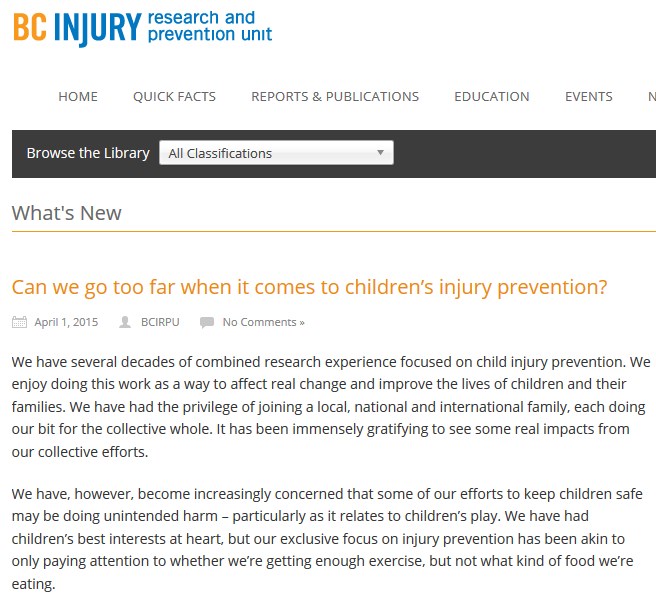

Paige’s Note: Tim Gill of rethinkingchildhood updates us, below, on the fight to bring sanity to the ASTM’s playground committee, who essentially feel that children are only safe playing on surfaces equivalent to bubble wrap. If they now pass a ballot requiring even more stringent (and highly expensive!) safety surfacing on playgrounds, they will be doing so against the recommendations of academic injury researchers. Why might they flout the advice of such experts? Quite coincidentally, there is alot of money to be made in safety surfacing. Feel free to voice your views to Joe Koury (jkoury@astm.org) who is the staff contact, and George Sushinsky (gsushinsky@gmail.com) who is the chair of the committee.
Leading child injury prevention researchers at the British Columbia Injury Research and Prevention Unit have today called on ASTM to put on hold its proposal to tighten playground surfacing standards.
The call is in an article written by Associate Profs Mariana Brussoni and Ian Pike of the Unit, along with Associate Prof Alison Macpherson of the School of Kinesiology & Health Science at York University. Between them, the authors have decades of research experience in child injury prevention.
In the piece, posted on the Unit’s website, the authors state that they have “become increasingly concerned that some of our efforts to keep children safe may be doing unintended harm – particularly as it relates to children’s play.” They also argue that “changing the standards will not reflect the best decision for children.”
The authors conclude by urging ASTM to “put the proposal on hold, and to engage in a wider debate about how standards can help us get the balance right.”
In making their case, the authors make five key points, informed by their position as independent and impartial experts in injury prevention:
- Head injuries on the playground are extremely rare and there is no evidence that they are increasing on playgrounds.
- The head injury criterion (HIC) is measured by dropping a head form straight down, but children do not fall that way.
- Ripping out and replacing surfacing is a very expensive proposition.
- Kids want and need to take risks and experience uncertainty. So reducing risks has major ramifications.
- We are doing a miserable job of providing stimulating play opportunities for children.
The article, which has numerous links to peer reviewed academic papers, echoes the case made recently in a paper by Prof David Ball, Professor of Risk Management at Middlesex University’s Centre for Decision Analysis and Risk Management, and by me here in January, with an update in March. It is also a model of brevity and clarity.
We know from ASTM that there will a month-long ballot of members of the committee, which will begin in the next day or two. The authors have asked ASTM to distribute their paper along with the ballot notice. Let’s hope it does.
Let’s hope too that committee members consider carefully the paper’s arguments.
Surely when even injury prevention experts who have devoted decades to reducing child accidents imply that playground safety has gone too far, it is time to stop.
The post ASTM still thinks grass is unsafe for kids: updates on the Great Safety Surfacing Debate appeared first on Playscapes.